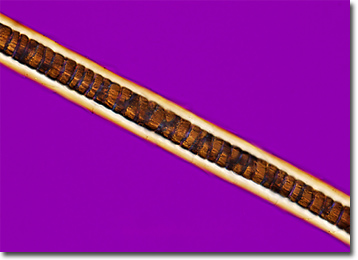Polarized Light Microscopy Digital Image Gallery
Timber Wolf Hair
The timber wolf, which is also known as the gray wolf or by its scientific name (Canis lupis), is the largest wild dog in the world. Males, which may be formidable foes, may be more than six feet long and weigh as much as 175 pounds, but females tend to be somewhat smaller.

View a second image of Timber Wolf Hair
Timber wolves have a wide natural distribution that extends across most of North America and includes much of Europe, Asia, India, and China. However, the powerful carnivores have suffered from human encroachment and their numbers have been reduced or eradicated altogether from a significant amount of their former range. In North America, for instance, where the timber wolf was honored and respected by Native Americans for thousands of years, the wild animals are now primarily restricted to Canada and Alaska, although reintroduction into other areas is underway.
Pack animals, timber wolves usually live in family groups that possess a clear hierarchy of its members. Only the dominant male and female in a pack are allowed to mate, although all members play a role in the care of the young that are produced. Young wolves usually stay with the pack until they achieve sexual maturity and then leave to begin new packs, spreading to new areas in order that there may be sufficient prey to consume. Primarily active at night, timber wolves prefer to feed upon deer, caribou, and other large herbivores that are separated from their group or are in some other way weakened, but will also consume small mammals, carrion, and occasionally vegetation.
